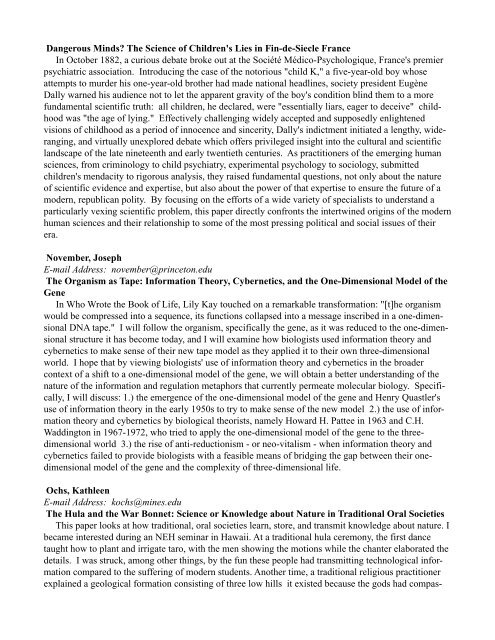Listing of Sessions and Abstracts of Papers - History of Science ...
Listing of Sessions and Abstracts of Papers - History of Science ...
Listing of Sessions and Abstracts of Papers - History of Science ...
You also want an ePaper? Increase the reach of your titles
YUMPU automatically turns print PDFs into web optimized ePapers that Google loves.
Dangerous Minds? The <strong>Science</strong> <strong>of</strong> Children's Lies in Fin-de-Siecle France<br />
In October 1882, a curious debate broke out at the Société Médico-Psychologique, France's premier<br />
psychiatric association. Introducing the case <strong>of</strong> the notorious "child K," a five-year-old boy whose<br />
attempts to murder his one-year-old brother had made national headlines, society president Eugène<br />
Dally warned his audience not to let the apparent gravity <strong>of</strong> the boy's condition blind them to a more<br />
fundamental scientific truth: all children, he declared, were "essentially liars, eager to deceive" childhood<br />
was "the age <strong>of</strong> lying." Effectively challenging widely accepted <strong>and</strong> supposedly enlightened<br />
visions <strong>of</strong> childhood as a period <strong>of</strong> innocence <strong>and</strong> sincerity, Dally's indictment initiated a lengthy, wideranging,<br />
<strong>and</strong> virtually unexplored debate which <strong>of</strong>fers privileged insight into the cultural <strong>and</strong> scientific<br />
l<strong>and</strong>scape <strong>of</strong> the late nineteenth <strong>and</strong> early twentieth centuries. As practitioners <strong>of</strong> the emerging human<br />
sciences, from criminology to child psychiatry, experimental psychology to sociology, submitted<br />
children's mendacity to rigorous analysis, they raised fundamental questions, not only about the nature<br />
<strong>of</strong> scientific evidence <strong>and</strong> expertise, but also about the power <strong>of</strong> that expertise to ensure the future <strong>of</strong> a<br />
modern, republican polity. By focusing on the efforts <strong>of</strong> a wide variety <strong>of</strong> specialists to underst<strong>and</strong> a<br />
particularly vexing scientific problem, this paper directly confronts the intertwined origins <strong>of</strong> the modern<br />
human sciences <strong>and</strong> their relationship to some <strong>of</strong> the most pressing political <strong>and</strong> social issues <strong>of</strong> their<br />
era.<br />
November, Joseph<br />
E-mail Address: november@princeton.edu<br />
The Organism as Tape: Information Theory, Cybernetics, <strong>and</strong> the One-Dimensional Model <strong>of</strong> the<br />
Gene<br />
In Who Wrote the Book <strong>of</strong> Life, Lily Kay touched on a remarkable transformation: "[t]he organism<br />
would be compressed into a sequence, its functions collapsed into a message inscribed in a one-dimensional<br />
DNA tape." I will follow the organism, specifically the gene, as it was reduced to the one-dimensional<br />
structure it has become today, <strong>and</strong> I will examine how biologists used information theory <strong>and</strong><br />
cybernetics to make sense <strong>of</strong> their new tape model as they applied it to their own three-dimensional<br />
world. I hope that by viewing biologists' use <strong>of</strong> information theory <strong>and</strong> cybernetics in the broader<br />
context <strong>of</strong> a shift to a one-dimensional model <strong>of</strong> the gene, we will obtain a better underst<strong>and</strong>ing <strong>of</strong> the<br />
nature <strong>of</strong> the information <strong>and</strong> regulation metaphors that currently permeate molecular biology. Specifically,<br />
I will discuss: 1.) the emergence <strong>of</strong> the one-dimensional model <strong>of</strong> the gene <strong>and</strong> Henry Quastler's<br />
use <strong>of</strong> information theory in the early 1950s to try to make sense <strong>of</strong> the new model 2.) the use <strong>of</strong> information<br />
theory <strong>and</strong> cybernetics by biological theorists, namely Howard H. Pattee in 1963 <strong>and</strong> C.H.<br />
Waddington in 1967-1972, who tried to apply the one-dimensional model <strong>of</strong> the gene to the threedimensional<br />
world 3.) the rise <strong>of</strong> anti-reductionism - or neo-vitalism - when information theory <strong>and</strong><br />
cybernetics failed to provide biologists with a feasible means <strong>of</strong> bridging the gap between their onedimensional<br />
model <strong>of</strong> the gene <strong>and</strong> the complexity <strong>of</strong> three-dimensional life.<br />
Ochs, Kathleen<br />
E-mail Address: kochs@mines.edu<br />
The Hula <strong>and</strong> the War Bonnet: <strong>Science</strong> or Knowledge about Nature in Traditional Oral Societies<br />
This paper looks at how traditional, oral societies learn, store, <strong>and</strong> transmit knowledge about nature. I<br />
became interested during an NEH seminar in Hawaii. At a traditional hula ceremony, the first dance<br />
taught how to plant <strong>and</strong> irrigate taro, with the men showing the motions while the chanter elaborated the<br />
details. I was struck, among other things, by the fun these people had transmitting technological information<br />
compared to the suffering <strong>of</strong> modern students. Another time, a traditional religious practitioner<br />
explained a geological formation consisting <strong>of</strong> three low hills it existed because the gods had compas-
















